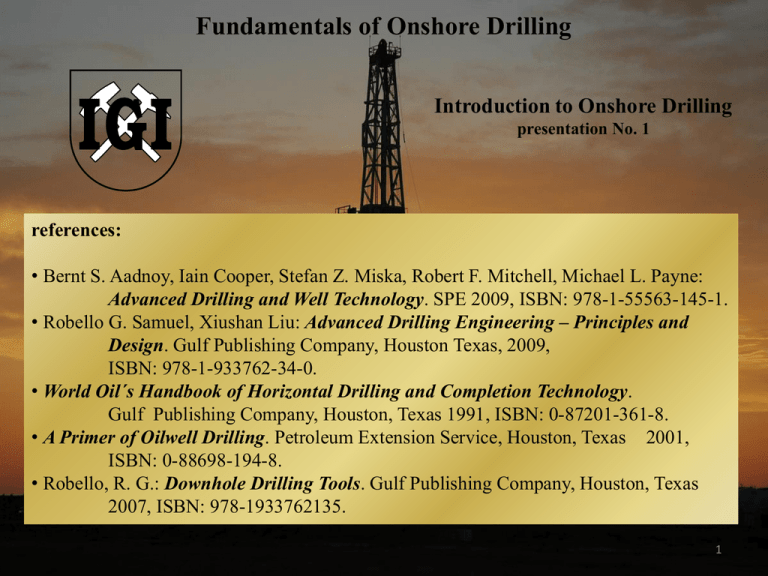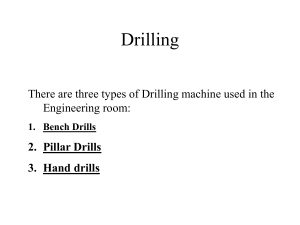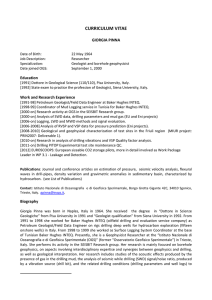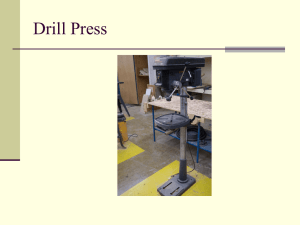Snímek 1
advertisement

Fundamentals of Onshore Drilling Introduction to Onshore Drilling presentation No. 1 references: • Bernt S. Aadnoy, Iain Cooper, Stefan Z. Miska, Robert F. Mitchell, Michael L. Payne: Advanced Drilling and Well Technology. SPE 2009, ISBN: 978-1-55563-145-1. • Robello G. Samuel, Xiushan Liu: Advanced Drilling Engineering – Principles and Design. Gulf Publishing Company, Houston Texas, 2009, ISBN: 978-1-933762-34-0. • World Oil´s Handbook of Horizontal Drilling and Completion Technology. Gulf Publishing Company, Houston, Texas 1991, ISBN: 0-87201-361-8. • A Primer of Oilwell Drilling. Petroleum Extension Service, Houston, Texas 2001, ISBN: 0-88698-194-8. • Robello, R. G.: Downhole Drilling Tools. Gulf Publishing Company, Houston, Texas 2007, ISBN: 978-1933762135. 1 Fundamentals of Drilling drilling means to make a hole in order to get access to the earth´s subsurface Objectives may be • gaining information about the subsurface from sampling/testing/logging => hole discarded • production/injection of fluids/gases (oil/gas/water) => hole completed into well • monitoring of subsurface properties (aquifer preassure, stress state, etc.) => hole completed into well objectives define hole/well construction 2 Fields of Drilling Applications Exploration/Production of Natural Resources - Oil and Gas - Water - Geothermal Energy Site Investigation - Scientific - Foundation/Construction - Environmental Mining Exploration Blast Hole/Seismic - Quarry 3 Drilling Techniques – Classification by Hole Making Methods 4 Principles of Drilling Techniques – Percussion Cabel Tool Drilling very old drilling technique (applied more than 2000 years ago by the Chinese) 2 Phase Technique (discontinuous) Phase 1: Rock Drilling free falling bit strikes the bottom with a heavy blow – repeated lifting and dropping makes the bit drill Phase 2: Removal of Cuttings interruption of drilling to remove cuttings by bailing • suitable only for hard rock • total efficiency of drilling process is fairly low 5 Principles of Drilling Techniques – Percussion Cabel Tool Drilling 6 Principles of Drilling Techniques – Rotary Drilling Drilling Fluid is circulated by being pumped down the drill string The Drill String is rotated to turn the bit; it is fed down as the bit penetration Bit is pushed into the bottom and rotation makes it cut Return circulation carries cuttings up the annulus between the drill string and the wall of the hole Key Elements: - Drill Bit -Drill String - Drilling Fluid 7 Types of Rotary Bits Performance Parameters of Drill Bits: Penetration Rate (Drilling Speed: m/h) Bit Life (Meters Drilled) Rock Characterization soft Roller Cone Bit Milled Steel Tooth very hard Roller Cone Bit Tungsten Carbide (inserts) medium hard soft Diamond Bit Natural Diamonds Diamond Bit Polycrystalline Diamond Compact Cutters 8 Cutting Action of Rotary Drill Bits 9 Cutting Action of Rotary Drill Bits Cones of Roller Bits do only roll on the bottom but always Slide, Tear and Gouge Offset of cones increases Sliding, Tearing, Gouging action 10 Elements of Roller Cone Bits Shape Types of Inserts 11 Bottom Hole Cleaning of Roller Cone Bits Schematic of Nozzles Action Effect of Nozzle Velocity on Rate of Penetration 12 Typical Operating Parameters for Roller Cone Inserts Bits 13 Cutting Action of Diamond Bit 14 Cutting Action of Diamonds 15 Sizes and Texture of Hard Rock Cuttings Dependent on Bit Type 16 Operating Parameters of Diamond Bits 17 Typical Rotary Drill String Assembly The drill string is the mechanical assemblage connection the rotary drive on surface to the drilling bit on bottom of the hole Functions of the Drillstring: • flow line for circulating drilling fluid • provides weight on bit • transmits rotation and torque to bit • guides and controls trajectory of the bit Main Components: • Drill Collars: thick wall steel pipe with Pin/Box threaded connection • Drill Pipe: steel pipe with Pin/Box threaded toolioints Ancillary Components: • crossover subs • stabilizers • reamers 18 Rotary Drillpipe Characteristics Tooljoint Pin and Box Tooljoint Welded 18 Rotary Drillpipes are standartized by API Outer Diameter of Pipe Body Steel Grades of Pipe Body 5 ½“ 5“ 4 ½“ 4“ 3 ½“ 2 7/8“ 2 3/8“ E – 75 X – 95 G – 105 S - 135 1“ = 2,54 cm Nominal Weight of Pipe Body Pipe Lenght Range 1: 18 – 22 ft Range 2: 27 – 30 ft Range 3: 38 – 45 ft Wall Thickness 1 ft = 30,48 cm Tool Joints Steel Grade: 120 000 psi (827,4 Mpa) Thread Type: NC 50, NC 38 Friction welded with upset pipe body annealed and machined 19 Drill Pipe Problems Drill pipe is the most stressed component of rotary equipment!!! Tension Bending (While Rotation) Reversal Stresses Torque Burst (Inside Pressure) Fratigue 20 Putting Weight on Bit by Drill Collars Buckling of Drillpipe under Compressional Load! 21 Typical Examples for Stabilized Bottom Hole Assemblies (BHA) 22 Drilling Fluid – Why it´s Called MUD 23 Drilling Mud – A Multipurpose Fluid Major Functions: • Bottomhole Cleaning • Cuttings Transport • Borehole Wall Support • Balancing Formation Pressure • Cooling the Bit • Hydraulic Power Transmission • Data transmission (MWD) • Reducing Friction • Corrosion Protection • Scientific Information Carrier 24 Drilling Fluid Circulating Pumps Typical Operating Parameters: max pressure: 35 Mpa 17 ½“ = 3 500 l/min 12 ¼“ = 2 500 l/min 8 ½“ = 1 500 l/min 6“ = 600 l/min heavyweight rigs => 2 pumps 1 200kW lightweight rigs => 2 pumps 600 kW 25 Principal Functions of a Rotary Drilling Rig 26 Main Components of the Hoisting System 27 Schematic of a Rotary Rig´s Block and Tackle 28 Hoisting System of Drilling Rigs – Hoisting Tower Derrick Structural tower assembled/ dismantled piece by piece Assembling/ dismantling is time consuming Used mainly offshore Square shaped rig floor 29 Hoisting System of Drilling Rigs – Hoisting Tower Mast A-shaped structure which can be pulled or lowered to a upright position by the drawworks without completely assembling or disassembling Good mobility Used mainly with onshore rigs 30 Rotary Rig Drawworks Advantages of Gear Driven Drawworks: • high performance • high availability • less noise • less vibration • increased safety 31 Rotating the Drillstring with a Rotary Table 32 Rotating the Drillstring with a Top Drive TOP DRIVE means a Power Swivel which directly turns the drillstring without need for a kelly and rotary table Advantages of a Top Drive Systém: drill string can be pulled out while rotating and circulating → Back Reaming can be reconnected to the drill string at any mast height during tripping drilling with 3-joint stands of drill pipe is possible with hydraulic driven power swivel static torque can be applied for much longer time Save time!!! Safer and easier operation!!! 33 Drilling Rig – LOC 400 34 35 36 Classification of Drilling Rigs Classification by Depth Rating: lightweight rigs: 1 500 – 2 000 m intermediate rigs: 3 500 m heavyweight rigs: 6 000 m ultraheavy rigs: 8 000 – 10 000 m Classification by Horsepower: Rule of Thumb: every 100 ft (30,5 m) of borehole requires 10 HP (7,5 kW) at drawworks lightweight rigs : 650 HP (484,7 kW) intermediate rigs : 1 300 HP (969,4 kW) heavyweight rigs : 2 000 HP (1491 kW) ultraheavy rigs : 3 000 HP (2 237 kW) 37 Typical Rig Organization Scheme 38 Drilling Contracts 39 THE END!!! 40 41





